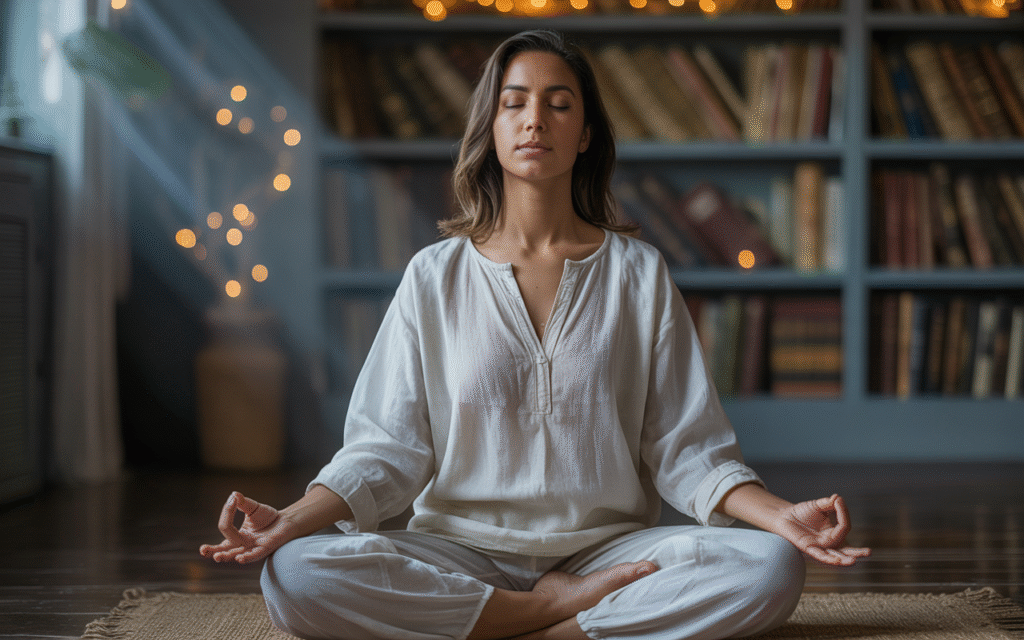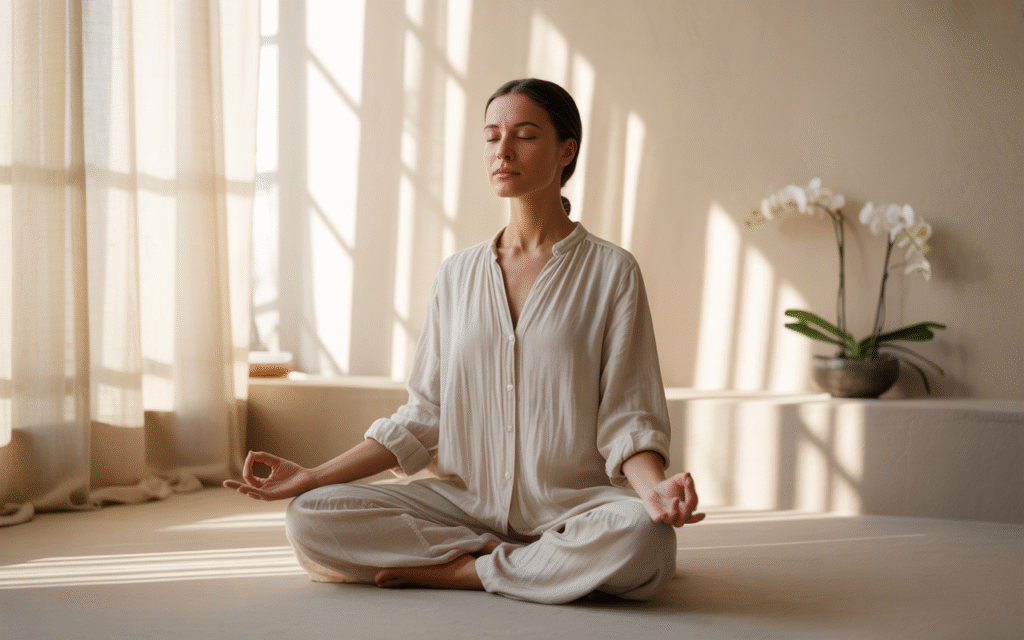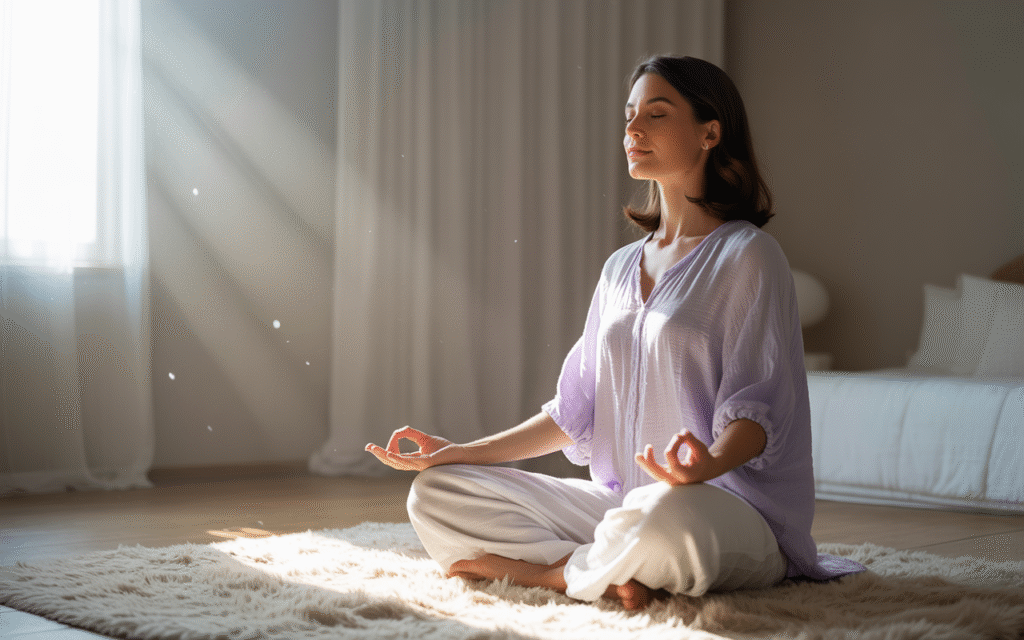Yoga Nidra for Better Sleep: The Practice That’s Replacing Melatonin

It’s 2 AM and you’re staring at the ceiling again, mind racing through tomorrow’s to-do list while your phone glows with another “just checking” social media scroll.
Sound familiar? If you’re one of the 70 million Americans dealing with sleep disorders, you’re not alone. But what if I told you there’s a 2,500-year-old practice that’s proving more effective than sleeping pills – and it doesn’t come with any side effects?
Meet yoga nidra, the ancient “yogic sleep” practice that’s quietly revolutionizing how we approach bedtime. While everyone’s talking about expensive sleep trackers and the latest melatonin supplements, this simple guided relaxation technique is helping people fall asleep naturally and stay asleep longer. The best part? You can start tonight, right from your own bed.
What Exactly is Yoga Nidra?

Let’s clear something up right away – yoga nidra isn’t your typical yoga class. There are no downward dogs, no sweaty sequences, and no need for those fancy leggings. You’ll be lying down the entire time, which already makes it my favorite type of yoga!
Yoga nidra literally translates to “yogic sleep,” but it’s more accurately described as conscious deep relaxation. Think of it as that sweet spot between being awake and asleep – you’re fully relaxed but still aware of what’s happening around you.
This ancient tantric practice was modernized in the 1960s by Swami Satyananda, who developed a systematic approach that anyone can follow.
Here’s what makes yoga nidra different from regular meditation:
You’re lying down comfortably instead of sitting upright trying not to fidget. It’s completely guided, so there’s no pressure to figure out what to do with your wandering mind.
It focuses on the body-mind connection through systematic relaxation rather than trying to empty your thoughts. And most importantly for sleep, you set a specific intention (called a sankalpa) that your subconscious mind absorbs while you’re in this deeply relaxed state.
The magic happens because yoga nidra activates your parasympathetic nervous system – that’s your body’s “rest and digest” mode that naturally prepares you for sleep. It’s like flipping a biological switch that tells your entire system it’s safe to let go and drift off.
Why Our Modern Sleep Solutions Aren’t Working

Before we dive into how yoga nidra can transform your nights, let’s talk about why we’re all struggling so much with sleep in the first place. Our great-grandparents didn’t need sleep apps and melatonin gummies – so what changed?
The culprits are everywhere: blue light from screens tricking our brains into thinking it’s daytime, chronic stress keeping our cortisol levels elevated, and minds that never truly get a break from the constant information overload. We’re essentially asking our Stone Age brains to adapt to Space Age stimulation, and frankly, they’re not having it.
Traditional meditation can be helpful, but let’s be honest – when you’re lying in bed with anxiety about tomorrow’s presentation, sitting cross-legged and trying to “clear your mind” isn’t exactly realistic. Your brain needs something more structured and soothing.
And then there’s the melatonin problem. While these supplements can be helpful occasionally, many people find they build up tolerance, experience grogginess the next day, or become psychologically dependent on them. Plus, they don’t address the root cause – they just try to chemically override your body’s natural systems.
The Science Behind Why Yoga Nidra Works for Sleep

This isn’t just ancient wisdom – there’s real science backing up why yoga nidra is so effective for sleep. When you practice yoga nidra, your brain actually shifts through different brainwave states, moving from the alert beta waves of normal waking consciousness down through alpha waves (relaxed awareness) and into theta waves (the dreamy state right before sleep).
Recent studies have shown that regular yoga nidra practice can improve sleep quality by up to 80%, reduce the time it takes to fall asleep, and decrease the number of nighttime awakenings. One study published in the International Journal of Yoga found that participants practicing yoga nidra showed significant improvements in sleep quality after just 30 days.
But here’s what really gets me excited about the research: yoga nidra doesn’t just help you sleep better – it actually reduces cortisol levels (your stress hormone) and increases the production of natural melatonin. So instead of relying on external supplements, you’re training your body to produce its own sleep-promoting chemicals.
The reason it works when your mind “won’t turn off” is because yoga nidra doesn’t ask you to stop thinking. Instead, it gives your mind something specific and soothing to focus on, gently guiding your attention away from worries and toward relaxation.
Your Complete Yoga Nidra Sleep Practice

Ready to try it for yourself? Here’s a complete yoga nidra sequence designed specifically for sleep. The entire practice takes about 35 minutes, but don’t worry if you fall asleep before it’s over – that’s actually the goal!
Setting Up Your Sleep Sanctuary (5 minutes)
First, create your space. You’ll want to be lying down comfortably – your bed is perfect, but you can also use a yoga mat with pillows and blankets. The room should be cool, dark, and quiet. Put your phone on airplane mode (seriously, do it now).
Lie down on your back with your arms slightly away from your body, palms facing up. Let your feet fall open naturally. If you have lower back issues, place a pillow under your knees. Cover yourself with a blanket – your body temperature will drop as you relax.
Close your eyes and take three natural breaths, allowing each exhale to help you settle more deeply into your space.
Setting Your Sleep Intention (Sankalpa)
Now comes one of the most powerful parts of the practice. In yoga nidra, we set what’s called a sankalpa – a positive intention or resolution that plants a seed in your subconscious mind.
For sleep, your sankalpa might be something like “I sleep deeply and peacefully through the night,” “My body knows how to rest and restore itself,” or “I wake up refreshed and energized.” Choose something that feels true and positive for you, and keep it the same for at least a few weeks of practice.
Repeat your sankalpa three times silently to yourself, really feeling the words as truth.
Body Awareness Journey (15 minutes)
This is where the magic happens. We’re going to systematically relax every part of your body, creating a wave of release from head to toe.
Start by bringing your attention to the top of your head. Don’t try to relax it – just notice it. Now slowly move your awareness down to your forehead, allowing it to soften. Notice your eyebrows, your eyelids, the space around your eyes.
Bring your attention to your cheeks, feeling them release. Notice your jaw – let it drop open slightly. Feel your tongue resting softly in your mouth. Your neck and throat, releasing any tension from the day.
Move down to your right shoulder, letting it drop heavily into your support. Your right upper arm, elbow, forearm. Your right wrist, hand, and each finger – thumb, index, middle, ring, and pinky. Let your entire right arm feel heavy and relaxed.
Now your left shoulder, dropping and releasing. Your left upper arm, elbow, forearm, wrist, hand, and each finger. Both arms now completely relaxed and heavy.
Bring your attention to your chest, feeling it rise and fall naturally with your breath. Your heart beating steadily, your lungs breathing effortlessly. Your upper back, middle back, lower back – all releasing and softening.
Notice your abdomen, soft and relaxed. Your pelvis, your hips, releasing any tension you’ve been carrying.
Now your right hip, thigh, knee. Your right calf, ankle, foot. Each toe of your right foot – big toe, second toe, middle toe, fourth toe, and little toe.
Your left hip, thigh, knee. Left calf, ankle, foot, and each toe. Both legs now heavy and completely relaxed.
Take a moment to feel your entire body, from the top of your head to the tips of your toes, completely relaxed and supported.
Breath and Energy Awareness (5 minutes)
Without trying to change anything, simply observe your natural breath. Feel the gentle rise and fall of your chest and belly. Notice how your body breathes itself without any effort from you.
Imagine that with each exhale, you’re releasing any remaining tension, worry, or energy from the day. With each inhale, you’re welcoming in peace, calm, and the perfect preparation for sleep.
Feel the energy in your body settling, like sediment in a clear pond. Everything becoming still and quiet.
Visualization and Sleep Transition (10 minutes)
Now imagine yourself in the most peaceful place you can think of. Maybe it’s a quiet beach at sunset, a cozy cabin in the woods, or even just your bed on the perfect sleeping night.
See yourself there, completely safe and comfortable. Feel the peace of this place surrounding you like a soft blanket. This is your sanctuary, your place of perfect rest.
As you rest in this peaceful place, feel yourself naturally becoming drowsier and more relaxed. Your body knows exactly how to move from this relaxed state into natural, restorative sleep.
If you’re still awake, gently repeat your sankalpa three more times, then simply allow yourself to drift into sleep whenever your body is ready.
Making Yoga Nidra Work for Your Sleep Challenges

Not everyone’s sleep struggles are the same, so here’s how to customize your practice:
If you’re a racing mind insomniac, spend extra time on the body awareness section. The systematic focus gives your mind something specific to do instead of spinning through worries.
If you hold physical tension, slow down the body scan even more. Really feel each part releasing before moving on to the next.
If anxiety keeps you awake, put extra emphasis on your sankalpa and the visualization. Create the most soothing, safe mental environment possible.
For timing, ideally practice 30-60 minutes before you want to be asleep. But even if you only have 15 minutes, a shortened version focusing on body awareness and breath can be incredibly effective.
Troubleshooting Your Practice

Let’s address the most common questions I get about yoga nidra for sleep:
“I fall asleep during the practice – am I doing it wrong?” Absolutely not! Falling asleep during yoga nidra is completely normal and actually shows that your nervous system is responding perfectly. The practice is doing exactly what it’s supposed to do.
“My mind still races sometimes.” This is totally normal, especially when you’re starting out. The goal isn’t to have zero thoughts – it’s to have a different relationship with your thoughts. Just keep bringing your attention back to the guidance when you notice you’ve drifted.
“I don’t have time for 35 minutes.” Even a 10-15 minute version can be helpful. Focus on the body scan and breath awareness portions – these are the most essential for sleep preparation.
“It works sometimes but not others.” Consistency is key with yoga nidra. Try to practice at roughly the same time each night, even if you’re not feeling particularly sleepy. You’re training your nervous system, and like any training, it takes repetition.
The Bonus Benefits You Didn’t Expect

While better sleep is obviously the main goal, don’t be surprised if you notice some unexpected improvements. Regular yoga nidra practice often leads to reduced anxiety and depression symptoms, better emotional regulation throughout the day, increased creativity and problem-solving abilities, and improved relationships (because let’s face it, we’re all nicer when we’re well-rested).
Many people also report that yoga nidra helps with physical healing and immune system function. When your body gets consistent, quality rest, it has the energy and resources to repair and restore itself more effectively.
Building Your Personal Sleep Practice

Start simple. Commit to practicing yoga nidra for sleep for just one week, using the script I’ve provided above. You can record yourself reading it slowly (leave plenty of pauses) or find guided recordings online.
Pay attention to how you feel – not just your sleep quality, but your mood, energy, and overall sense of wellbeing during the day. Most people notice some improvement within the first few nights, with more significant changes after 2-3 weeks of consistent practice.
As you get more comfortable with the practice, you can start customizing it to your needs. Maybe you want to spend more time on visualization, or perhaps you prefer a longer body scan. The beauty of yoga nidra is that it’s completely adaptable to what works best for you.
Your Journey to Natural Sleep Starts Tonight

Here’s what I love most about yoga nidra for sleep: it’s not another thing you have to buy, schedule, or depend on. It’s a skill you can develop that will serve you for the rest of your life. No side effects, no tolerance buildup, no midnight pharmacy runs for more supplements.
The practice I’ve shared with you tonight has helped thousands of people reclaim their sleep and, honestly, their lives. Better sleep affects everything – your mood, your relationships, your work performance, your physical health. It’s truly one of the most powerful things you can do for your overall wellbeing.
So tonight, instead of reaching for your phone or another sleep aid, try lying down with this yoga nidra practice. Give yourself permission to rest deeply and naturally. Your body remembers how to sleep – sometimes it just needs a gentle reminder.
Sweet dreams, and here’s to waking up refreshed and ready for whatever tomorrow brings. Your best night’s sleep is just one practice away.






